Of all my high school classes, there are only a handful that I still remember vividly, decades later. One day, my English teacher, Mr. Englert, devoted the entire period to an analysis of the Beatles song, I Am The Walrus. Generally, when one thinks of a music appreciation class, it is natural to assume that the subject will be a classical piece or something operatic. Few people would imagine that a pop song might be worthy of the same treatment. As a typical high school student, I was obviously familiar with the Beatles, but I Am The Walrus wasn’t one of my favourites. It sounded weird, there was nothing remotely catchy about it, and it just didn’t do anything for me. However, by the end of the class, I was awestruck by how much detail there was in this song, and was particularly impressed with all of the literary references. That day I gained a new appreciation for The Beatles and understood why they were so revered. Looking back, I wish I had recorded that class.
A few years ago, I stumbled upon a pop song that (in my opinion) is on par with I Am The Walrus, and deserves its own analysis: Sub-Rosa Subway by Klaatu.
The Band: Klaatu is a Canadian band, best known for their song Calling Occupants Of Interplanetary Craft. The band’s name is based on a character from the 1951 movie The Day The Earth Stood Still. Sub-Rosa Subway was recorded in 1973 and released in 1976 on the album entitled 3:47 E.S.T. It was also released as a 45-rpm single, as the B-side of Calling Occupants. The album title, 3:47 E.S.T., was also taken from The Day The Earth Stood Still – it’s the time that the alien spaceship landed on Earth. While Sub-Rosa Subway wasn’t as popular as Calling Occupants, it did reach #62 on the Billboard Top 100 list in 1976.
The Title: Sub Rosa is a Latin phrase which means “under the rose”, and is associated with secrecy. In the Middle Ages, a rose hanging from the ceiling of a council chamber served as a reminder to those in attendance that anything said sub rosa was to be kept confidential. Roses were also painted on the ceilings of Roman banquet rooms to impress upon everyone that anything said sub vino (under the influence of wine) must also be considered sub rosa.
.
The Lyrics
Back in 1870, just beneath the Great White Way,
Alfred Beach worked secretly, risking all to ride a dream,
His wind machine.
The Great White Way is a nickname for Broadway, because it was one of the first streets in New York City to be completely illuminated by electric lights.
 Alfred Ely Beach (1826-1896) was an American publisher, lawyer and part-time inventor. He was the publisher of The New York Sun and Scientific American. More importantly, he built Manhattan’s first underground subway. Articles about the history of the New York City subway will usually state that the first underground line, known as the Interborough Rapid transit (IRT), began operating on October 27, 1904. However, New York City’s first underground subway was actually constructed – clandestinely, and without any official approval – 35 years earlier, by Alfred Beach.
Alfred Ely Beach (1826-1896) was an American publisher, lawyer and part-time inventor. He was the publisher of The New York Sun and Scientific American. More importantly, he built Manhattan’s first underground subway. Articles about the history of the New York City subway will usually state that the first underground line, known as the Interborough Rapid transit (IRT), began operating on October 27, 1904. However, New York City’s first underground subway was actually constructed – clandestinely, and without any official approval – 35 years earlier, by Alfred Beach.
By the 1860s, the traffic in New York City was already becoming unbearable, and mass transit alternatives were being considered. An elevated transit line was built from Greenwich Street and Ninth Avenue in 1867-1870, but Beach thought that a better solution was an underground transit system. He applied for a permit to excavate along Broadway, but it was not granted. Those who owned property along Broadway, including influential business leaders John Jacob Astor and Alexander Stewart, feared that excavation would increase traffic congestion, and that the tunnels might damage or threaten the structural integrity of the buildings.
Beach, who was not easily discouraged, applied for a permit in 1869 to create a pair of small subterranean pneumatic tubes to be used for postal and small package deliveries, and this was granted. During the construction, Beach secretly excavated a much larger space – a tunnel tunnel six feet in diameter – capacious enough to hold a subway car. While all this sounds very grandiose, it was more of a proof-of-concept idea than a practical transit system. The tunnel was only 300 feet long, curved 90 degrees, and finished at a dead end. There was only a single station, located in the basement of Devlin’s clothing store, on the south-west corner of Broadway and Warren Street.
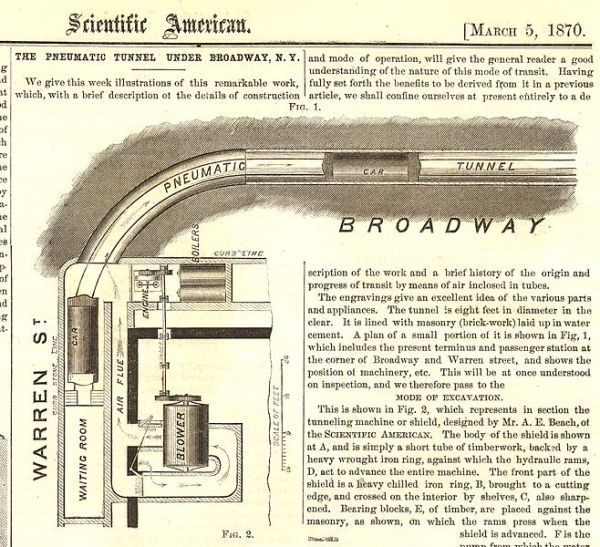
The Wind Machine: Beach’s transit experiment was essentially a pneumatic tube mail delivery system, but scaled up so that it could transport people. The tunnel was six feet in diameter, and contained a single carriage (designed and built by Beach) that could carry ten passengers. An eight-blade Helix fan, ten feet in diameter, rotating at 250 revolutions per minute and powered by a 15-horsepower steam engine, pushed air into the tunnel and moved the carriage along a set of tracks. After arriving at the terminus point, the fan was reversed, and the carriage was pulled back into the station.
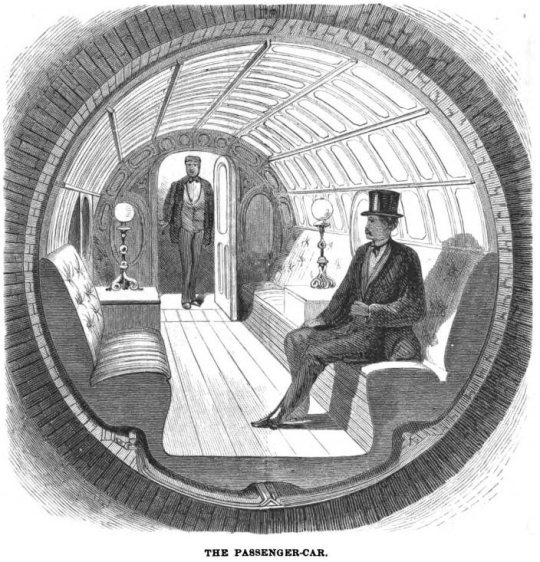
Opening day was February 26, 1870, and passengers paid 25¢ to ride this new form of transportation. During the first two weeks, 11,000 rides were sold, and 400,000 during the first year. Unfortunately, the public regarded it as little more than a curiosity, and Beach had a great deal of difficulty securing permits to allow its expansion. The pneumatic subway was in operation until April 1873, and then closed due to a lack of both funds and public support. The tunnels were sealed and the station was re-purposed.
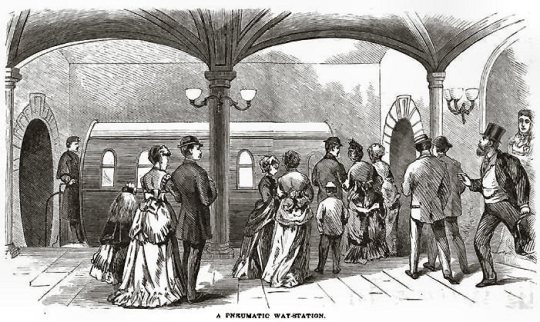
New York City and the morning sun,
Were awoken by the strangest sound,
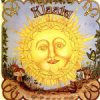 The morning sun is a reference to the sun face image that appears on all of Klaatu’s album covers. It’s also the name of their fan club’s newsletter. In a 1995 interview with Bill O’Leary, band member Dee Long explains the origins of the sun face symbol “The Sun face was Terry [Draper] and John [Woloschuk]’s idea. They felt that this was the best advertising we could possibly have, after all, the Sun comes up every day, in every part of the world. Hard to miss!”
The morning sun is a reference to the sun face image that appears on all of Klaatu’s album covers. It’s also the name of their fan club’s newsletter. In a 1995 interview with Bill O’Leary, band member Dee Long explains the origins of the sun face symbol “The Sun face was Terry [Draper] and John [Woloschuk]’s idea. They felt that this was the best advertising we could possibly have, after all, the Sun comes up every day, in every part of the world. Hard to miss!”
As for America’s first subway,
The public scoffed “It’s far too rude”,
One station filled with Victoria’s age,
From frescoed walls and goldfish fountains,
To Brahmsian tunes.
It’s hard to believe that anyone would scoff at the splendour of the station and carriage, especially when compared to most present-day North American subway cars and stations. The phrase “To Brahmsian tunes”, repeated until the end of the song, naturally refers to the music of classical composer Johannes Brahms (1833-1897). I imagine that the passengers must have been serenaded by live musicians inside the station, since it would be another seven years before Thomas Edison invented the gramophone.
Here is a Google Street View image of the south-west corner of Broadway and Warren Street, facing east. The people standing on the corner are situated almost directly over Alfred Beach’s pneumatic tunnel.
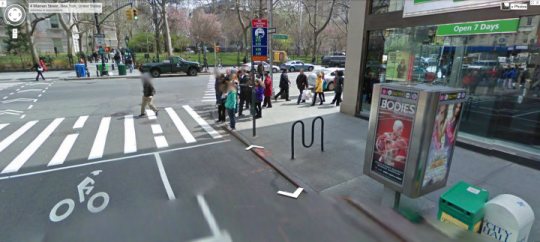
The Secret Message: If you listen carefully to the second half of the song, you’ll hear a stream of Morse code beginning at 2:51 (3:01 in the video, below) and lasting until 3:42. The timing assumes that the music begins at right at 0:00 with no leading silence. Interestingly (and, I suspect, not coincidentally), if you include the typical five seconds of silence between vinyl album tracks, then the Morse code ends at 3:47. It’s heard first in the left channel; then, from 3:09-3:16 it pans across to the right channel; at 3:35 it switches back to the left channel, and continues until 3:42. If your Morse code is a little rusty, band member John Woloschuk decoded the message in a fan magazine article:
From Alfred, heed thy sharpened ear,
A message we do bring,
Starship appears upon our sphere,
Through London’s sky come spring.
The starship sounds like a nod to Klaatu’s Calling Occupants song, since Sub-Rosa Subway was the B-side of that single. Pop musicians do reference other songs from time to time. For example, the Beatles song Glass Onion contains the line “The walrus was Paul”, and the Queen song Bicycle Race contains the line “Fat-bottomed girls”. However, there is still an additional mystery in this decoded verse. What is the significance of London? We know that the movie The Day The Earth Stood Still occurs during the spring, but the spaceship lands in Washington D.C.
I finally discovered the answer in a 1995 interview with band member Dee Long. When asked what the Morse code meant, Long replied “I don’t remember all of it, but it was based on an idea of Terry Brown’s [the producer of Klaatu’s 3:47 E.S.T. album]. It describes a spaceship landing in London, England, and we fantasized about faking a spaceship landing to promote our records. One of us would emerge from the craft as a (rather corny) stunt. I do recall hooking an old Morse code key up to the recording console and running a test tone through it. We had to write out the whole thing in dots and dashes, using a boy scout manual, before putting it to tape. I’m no Morse code expert and we had to slow the tape down because I could not do it fast enough to sound realistic.”
The Beatles Rumours
Shortly after Klaatu’s album, 3:47 E.S.T., was released, there were rumours that the band was actually The Beatles, trying to be incognito. Perhaps it was part of the zeitgeist of the 1970s – the following year, in 1977, it was revealed that the band Suzy and the Red Stripes was actually Paul McCartney and Wings. The Klaatu rumours were not true, but there were no shortage of reasons why listeners might have made this assumption:
- Both bands released albums on the Capitol record label.
- The band members seem to have taken the sub-rosa concept to heart – there are no names or photos of the band members on the album cover or liner notes.
- The are no producer or songwriter credits. The album states only “Produced by Klaatu” and “All selections composed by Klaatu”.
- The vocals sound a little like Paul McCartney.
- All but one of Klaatu’s albums were released before John Lennon’s death, in December, 1980.
- A mistaken assumption that The Great White Way was referring to The White Album.
One of the most compelling arguments for a Beatles connection is the cover of Ringo Starr’s 1974 album, Goodnight Vienna. In a scene that’s obviously based on the movie The Day The Earth Stood Still, Gort the robot stands beside Ringo Starr, who portrays the character of Klaatu.
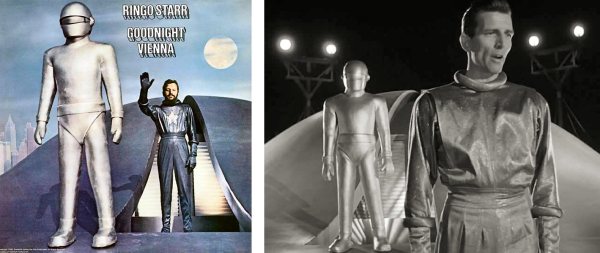
In addition to the reasons above, and those listed in the article link, I’ve added a few of my own, since there are quite a few musical similarities between Sub-Rosa Subway and Beatles music:
- The train-crossing bell sound (starting at 0:25) sounds like the ship’s bell on Yellow Submarine.
- The voice saying “It’s far too rude” (at 2:05), sounds like it’s being spoken from a megaphone, and is reminiscent of the spoken “megaphone-sounding” lines in Yellow Submarine.
- The horns at 1:02 and the trumpet arpeggios at 3:24 sound like the horns in Magical Mystery Tour and near the ending of All You Need Is Love.
- The hand clap samples at 2:15 sounds like the hand claps in the first bars of Ob La Di Ob La Da.
- In the song Calling Occupants, the piano notes at 1:05 sound like the notes at the beginning of I Am The Walrus.
- Also in the song Calling Occupants, the letter “O” in the line “Interstellar policeman” is not distinct, which makes the word sound like “p’liceman”. This results in a very similar pronunciation to a line in I Am The Walrus: “Mr. City p’liceman sitting pretty little p’licemen in a row”.
- Repetition of “To Brahmsian Tunes” line similar to the lyrical repetition in All You Need Is Love and Hey Jude.
Despite all of the speculation and fervent searching for clues, the rumours were false. There was no connection between Klaatu and The Beatles, as band member Terry Draper explains in this interview (starting at 1:48).
And finally, the song itself. Watch the video; listen to the lyrics; immerse yourself in the music.
Unlike the vast majority of pop music, this song demands much more of the listener; however, the rewards are also substantial for those who are willing to do a little research, explore the oblique historical references and solve the puzzles. In addition to enjoying a wonderful piece of music, you’ll learn a little history and also have some fun connecting a few dots. Just like classic literature, repeated listenings will uncover more and more detail, along with a growing appreciation of the work involved in creating this piece. In my opinion, Sub-Rosa Subway represents what pop music could be, and more importantly, what it should be.
.
.

Comments on: "Sub-Rosa Subway: A Hidden Pop Music Gem" (2)
We actually have Klaatu on vinyl here. I didn’t think anyone else had ever actually heard of them! hahahaha
Brilliant report, Watson. Well done!